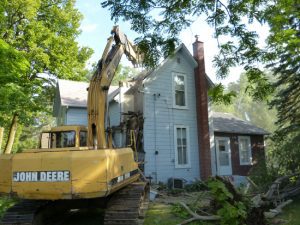
The demolition had been going on for over an hour. Layers of roofing, above the second floor were now caving in. Rafters that hadn’t seen the light of day for over a century and the walls that could tell stories of many of those years came cascading down. It was all quite controlled. With the precision of a surgeon, the excavator operator was bringing my neighbour’s house down piece by piece.
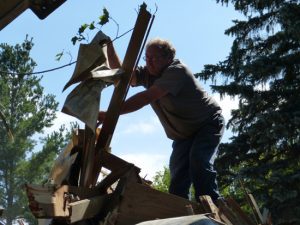
But suddenly the excavator shovel – Murray Huntington’s industrial scalpel – powered down. Huntington opened the excavator door, stepped out of the cab and climbed over the debris that had been the second floor.
“What’ve you got?” I called out to him from ground level.
“Maybe you can use this,” Huntington said.
And he gently tugged at a few of the floorboards atop the pile of rubble to reveal some paper. He’d spotted it in the debris, brought it down and handed it to me. It was a newspaper.
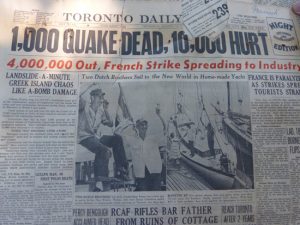 And – knowing how much I loved my neighbour Ronnie Egan and my fascination for history – he figured it might offer some insight about the house he’d been contracted to demolish. I carefully separated the newspaper sheets until I came to the front page.
And – knowing how much I loved my neighbour Ronnie Egan and my fascination for history – he figured it might offer some insight about the house he’d been contracted to demolish. I carefully separated the newspaper sheets until I came to the front page.
“1,000 quake dead, 10,000 hurt,” read the top headline, “Two Dutch brothers, sail to New World in home-made yacht,” read a second headline. And adding to the news of the day, “Guelph man, 40, first polio death,” read a third headline. And I thought, “Polio. I’ll bet it’s a newspaper from the 1950s.” I was right. It was the Toronto Daily Star, from August 13, 1953. And I said out loud, “Why would that be buried in the floorboards?”
“Likely the insulation when they re-did the floor,” Huntington said.
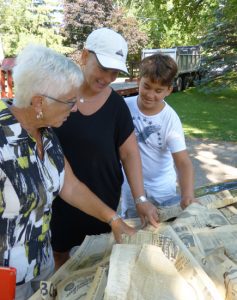
I looked at one of the others watching the demolition, one of Ronnie’s daughters, and Lynda Kroes nodded. One of those second-floor rooms had been her bedroom and she remembered the floor being fixed. She recalled another of the secrets of that part of the house. Pouring out of the now broken walls was a seemingly endless flow of sawdust, the upstairs wall insulation. “It was cold up there in the winter,” she admitted.
“When was the original house built?” I asked her.
She thought her father, Willis Egan, had said he was four when the house was purchased by his parents. “And Willis was born in 1918,” she said. So that put the age of the house around 100 years, a house built in the time of King Edward VII.
I remembered when my wife and I and our two daughters moved in next door. It was July 1, Canada Day, 1988. As it turned out it was Willis Egan’s birthday. And as we sat on the back stoop of the Egan house and shared a celebratory beer, I’d asked Willis to share some of his experiences. He said he’d grown up in that house, that he’d left work and that home to go off to fight in the Second World War.
Fortunately, he’d come home in one piece … and with a new bride, Rodine Doris Mary Buckley-Beevers Egan. And together they would write a new generation of family stories in that great old house at 29 Balsam Street North.
By that time, Murray Huntington’s excavator shovel was bringing down the last of the attic and upper floor. The building wasn’t looking like a house anymore. Just rubble. But unlike the sadness both Ronnie’s surviving family and some of the neighbours were feeling, for a moment, I was thinking how exciting it must have been for the original owners to be watching their brand new house go up back then. It would have been just before the Great War.
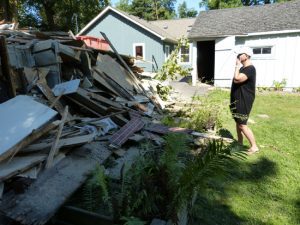
It would have been a time when Uxbridge, according to local historian Allan McGillivray, had a population of over 2,000, had witnessed a train wreck, and a couple of significant industrial fires, and Mayors Beale, Nicholls and Lapp.
But then Heather Cowan-Egan, Ronnie’s granddaughter-in-law, discovered another clue. Among the debris of what was left of Ronnie’s back kitchen, she found more newspaper. And it had different headlines.
“Cruisers will notify Smolensk,” declared one. And when I read further I learned it was a story about strained relations between Russia and Britain. Notice I didn’t say the Soviet Union. That’s because this newspaper, used for insulation in the Egan kitchen wall, was from pre-Bolshevik Revolutionary Russia. Indeed, the date was August 26, 1904. And that meant, maybe the house wasn’t built in the Edwardian era, but the Victorian era!
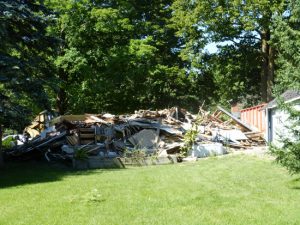 By day’s end, the Egan household – whether Edwardian or Victorian – was gone. Tears had been shed. Stories were shared among family, neighbours, passers-by, and an excavator operator. We’d all felt an attachment to that old house.
By day’s end, the Egan household – whether Edwardian or Victorian – was gone. Tears had been shed. Stories were shared among family, neighbours, passers-by, and an excavator operator. We’d all felt an attachment to that old house.
But I think our discoveries and our memories of the people and a beloved home were ultimately more valuable than the wood, plaster and pain of saying good-bye to a building coming down.
Hello Ted. Thank you for writing this article about my grandfather’s house in Uxbridge. My mother, Mary (Egan) McCormick grew up in that house. She was born in 1920 and is now in a nursing home in Midland. The article brought back many memories of holidays in the house and sleeping under feather ticks in the upstairs bedroom. I especially remember the large photograph of Auntie in her naval uniform that hung in the front parlour. I have several pictures of the house in its glory days with my grandfather, my aunt and uncle and cousins.
Hi Mary Ellen… How wonderful to hear from you and to know that the story about the house resonated for you. It’s been a sad few weeks, knowing the house was coming down and then watching the demolition. But notes such as yours make us realize it’s the people, not the buildings, who give us the memories. If you ever get a chance to send along a photo or two of the house in its glory days, I’d love to see them. Best… Ted.